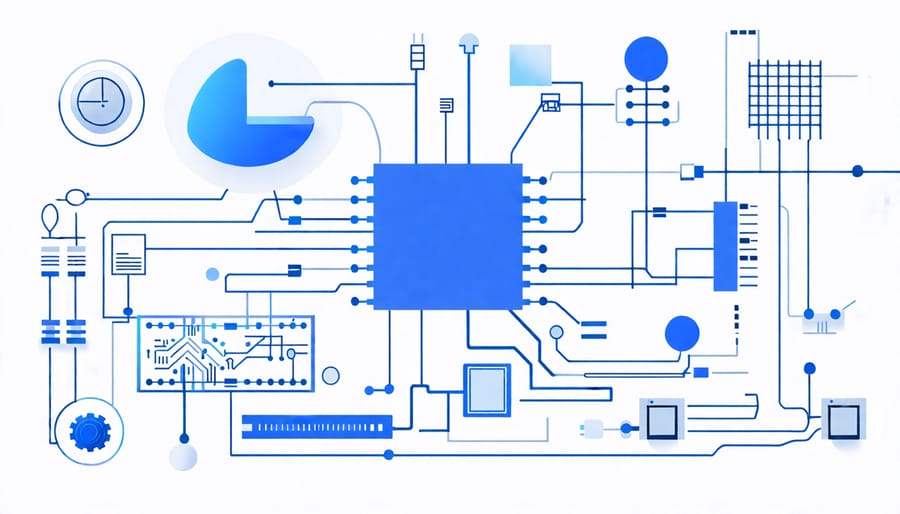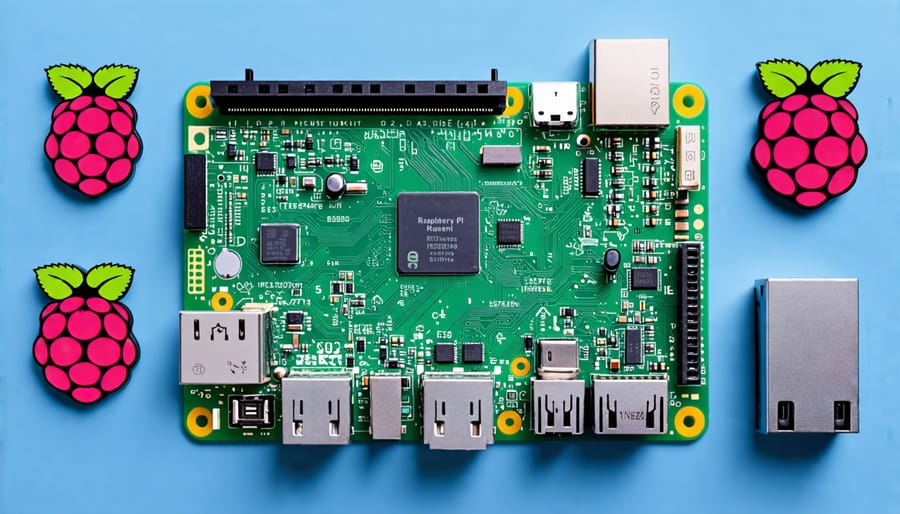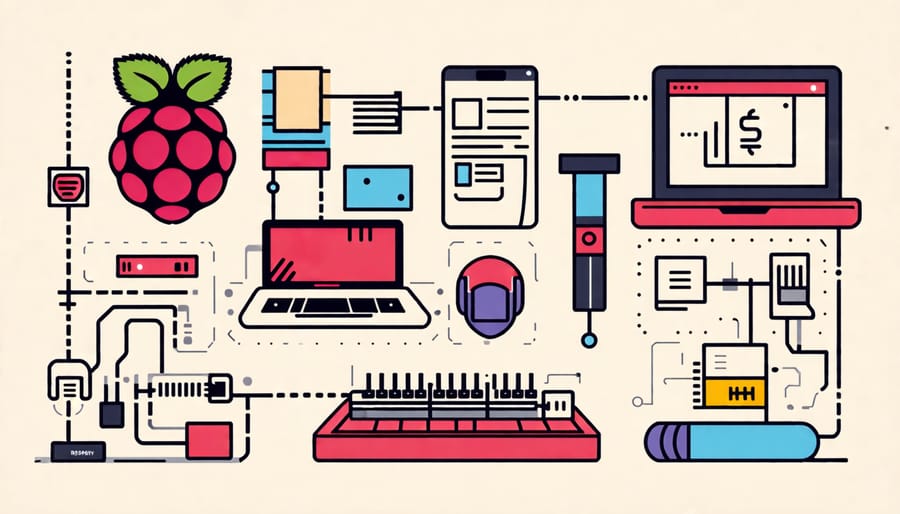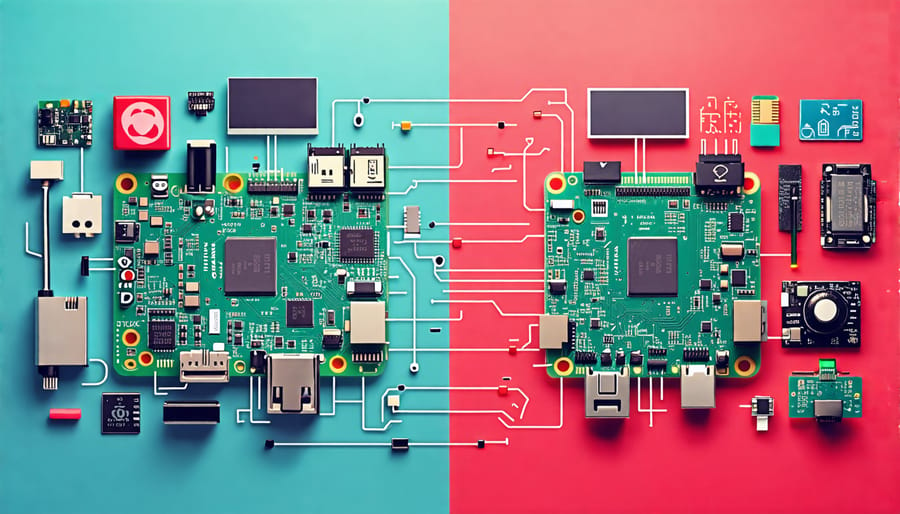Examine the essence of embedded systems by identifying devices that execute specific tasks autonomously. Recognize the Raspberry Pi as a versatile, credit-card-sized computer featuring remarkable processing power, capable of running full-fledged operating systems like Linux. Contrast its flexibility and expandability against traditional embedded systems, typically designed for single-purpose applications with limited user interaction. Explore Raspberry Pi’s application in real-world embedded projects such as smart home devices, weather stations, and custom robotics. Assess how its adaptability and cost-effectiveness make it a powerful tool for tech enthusiasts, hobbyists, and educators aiming to innovate through accessible, creative technology.
Defining Embedded Systems
Characteristics of Embedded Systems
Embedded systems are specialized computing systems designed to perform dedicated functions, often with real-time constraints. Unlike general-purpose computers like desktops and laptops, embedded systems are typically compact, highly power-efficient, and tailored for specific tasks. This makes them ideal for everything from household appliances to industrial machinery. A key characteristic is their small size, which allows them to be integrated into various environments without consuming significant space. They are also optimized for efficiency, meaning they can perform their designated functions with minimal energy usage.
These systems are crafted to perform a particular job, benefiting applications where single-purpose functioning is crucial. For instance, the microcontrollers in your car’s anti-lock braking system are embedded systems that continuously monitor and control braking functions. Such focus on dedicated tasks ensures reliability and responsiveness, suiting environments where consistency and precision are essential.
In summary, the distinctiveness of embedded systems lies in their specialized design, efficient performance, and ability to meet the constraints of specific applications, setting them apart from their general-purpose counterparts.

Typical Applications
Embedded systems play a crucial role in various technological advancements we use in our daily lives. In the realm of home appliances, embedded systems are the brains behind smart refrigerators, washing machines, and even microwaves, enabling automated, efficient operations. In automotive electronics, embedded systems manage engine performance, safety features like airbags and ABS, and enhanced infotainment systems, providing a smarter, safer driving experience. In healthcare, they are integrated into life-saving devices such as pacemakers, MRI machines, and monitoring systems, ensuring precise and reliable performance. Consumer electronics, like smartphones and gaming consoles, rely on embedded systems for seamless interaction and rich user experiences. In industrial environments, they power robotics and automation, improving manufacturing efficiency and precision. For tech enthusiasts and hobbyists, platforms like Raspberry Pi offer a versatile gateway to explore these applications, simulating real-world uses and encouraging innovation in developing novel projects. Ultimately, embedded systems are the silent drivers shaping the connected world around us.
Raspberry Pi: A General-Purpose Computer?
Hardware Overview
The Raspberry Pi, a versatile credit card-sized computer, often raises the question of whether it qualifies as an embedded system. Examining a typical Raspberry Pi model, like the Raspberry Pi 4, reveals its hardware prowess. It features a powerful 1.5GHz quad-core ARM Cortex-A72 CPU, making it capable of handling complex computations and multitasking. With up to 8GB of RAM, users can experience seamless performance even when running multiple applications. Connectivity is a highlight, with dual-band 802.11ac Wi-Fi, Bluetooth 5.0, and gigabit Ethernet offering various options for integration with other devices. What differentiates the Raspberry Pi models is their GPIO pins, allowing users to control electronics and sensors directly, showcasing its capacity as an embedded system for projects and innovations.

Intended Use Cases
The Raspberry Pi, a versatile computing device, is primarily designed for educational purposes, making it an ideal tool for introducing students and hobbyists to programming and electronics. Its affordability and simplicity ease the learning curve, allowing beginners to dive into coding and hardware projects without financial strain. Beyond education, the Raspberry Pi is a favorite among tech enthusiasts for prototyping. Its small size and powerful capabilities enable users to experiment with new ideas, develop innovative solutions, or build custom devices, such as home automation systems or personal media centers. These use cases highlight the Raspberry Pi’s role as a bridge between theoretical knowledge and practical application, fostering creativity and technical skills in both personal and professional settings.
Can Raspberry Pi Function as an Embedded System?
Raspberry Pi in DIY Projects
Raspberry Pi has become a staple in the world of DIY electronics, with hobbyists leveraging its versatility to breathe life into countless projects that parallel traditional embedded systems. For instance, the low-cost computer can power innovative home automation systems. With the right sensors, users can create custom smart home devices, like automated lighting and security systems, that provide real-time notifications and control via smartphone apps. Another popular application is in robotics; enthusiastic makers use the Raspberry Pi to build small robots that can navigate mazes or perform programmed tasks, utilizing its GPIO pins to connect various sensors and actuators.
Additionally, Raspberry Pi is utilized in eco-friendly solar-powered projects, demonstrating its potential in energy-efficient designs. Enthusiasts can use it to create weather stations or garden irrigation systems that operate untethered in remote areas. These projects highlight Raspberry Pi’s capability to function seamlessly in standalone roles, performing specific tasks while mirroring the characteristics of embedded systems. By integrating it into projects with dedicated purposes, tech enthusiasts not only gain practical experience but also contribute valuable insights into sustainable and efficient technology applications. Whether it’s automating your home, building a robot, or conserving energy, the potential for creativity and innovation with Raspberry Pi is truly limitless.

Case Studies in Industry
In recent years, Raspberry Pi has proven to be much more than just an educational tool or a hobbyist’s delight, making significant strides in more sophisticated, industry-grade projects. As an accessible, low-cost computing platform, Raspberry Pi’s versatility has led to innovative uses in various sectors. For example, in the realm of industrial applications, Raspberry Pi is being utilized for tasks such as monitoring and controlling manufacturing processes. It offers a cost-effective solution for small businesses looking to automate operations without hefty investments.
In agriculture, Raspberry Pi has been implemented to improve crop management systems. Farmers employ these devices equipped with sensors to collect data on humidity, temperature, and soil moisture, enabling precise farming practices. This not only enhances yield but also ensures sustainable resource usage.
Moreover, Raspberry Pi’s adaptability has found a niche in healthcare, where it’s used for patient monitoring and medical device prototyping. Its ability to process and relay data efficiently allows for real-time health assessments, contributing significantly to remote healthcare solutions.
These examples illustrate how Raspberry Pi functions effectively as an embedded system, seamlessly integrating into larger networks to perform specific, dedicated tasks. Such versatility underscores its growing role across diverse industries, making it a powerful component in the evolving landscape of technology.
Pros and Cons of Using Raspberry Pi as an Embedded System
Advantages
Raspberry Pi offers several advantages as an embedded system, making it a go-to choice for tech enthusiasts and educators alike. One of its primary benefits is cost-effectiveness. Raspberry Pi boards are available at a fraction of the price of traditional computers, offering a powerful platform for experimentation and learning without breaking the bank. This affordability makes it accessible for anyone interested in exploring embedded systems.
Flexibility is another key advantage. The Raspberry Pi can be easily customized with a wide range of peripherals and sensors, allowing users to tailor it to specific projects, from home automation to robotics. Its compact size and energy efficiency further enhance its practicality in various scenarios.
Community support is also a significant benefit. With a vast and active online community, users have access to countless tutorials, forums, and resources, providing support and inspiration for projects. This community-driven ecosystem fosters a collaborative environment where beginners and experts can share knowledge.
Lastly, the ease of development facilitated by accessible programming environments and comprehensive documentation allows even those new to programming to get started with Raspberry Pi, empowering users to transform ideas into real-world applications efficiently.
Limitations
While the Raspberry Pi is a versatile tool beloved by tech enthusiasts, it has its limitations compared to traditional embedded systems. One of the most notable drawbacks is its power consumption. Unlike many dedicated embedded systems designed to operate efficiently on minimal power, the Raspberry Pi requires a consistent power supply, making it less suitable for battery-operated projects.
In terms of size, although the Raspberry Pi is compact, it does not match the tiny footprints of microcontrollers often used in embedded applications. This can be a constraint when space is a crucial factor.
Performance-wise, while the Raspberry Pi offers a full-fledged computing experience, it might be overkill for specific tasks where a dedicated microcontroller chip would suffice. Moreover, its higher processing power might lead to unnecessary complexity and energy consumption for simple tasks.
Despite these limitations, the Raspberry Pi continues to be an excellent platform for learning and experimenting with embedded systems, provided users understand and work around these constraints.
Conclusion
Raspberry Pi continues to demonstrate its unparalleled flexibility, serving as both an educational tool and a practical solution in various embedded system projects. Throughout this exploration, we’ve seen how its features—such as a powerful processor, GPIO pins, and extensive software support—position it as a viable embedded system, enabling endless possibilities. Whether you’re a tech enthusiast, hobbyist, or educator, Raspberry Pi invites you to experiment and innovate, bridging theory with hands-on application. Embrace future projects that challenge your creativity, be it in home automation, robotics, or educational settings, and discover new ways to harness the power of this versatile platform.


